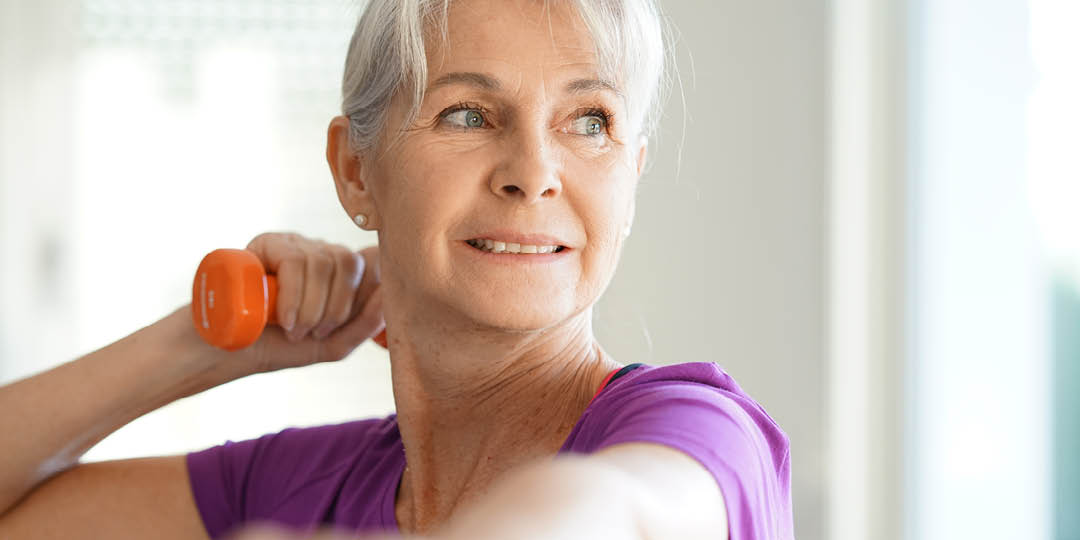Exercising and Aging
From the time you are born to around the time you turn 30, your muscles grow larger and stronger, at some point in your 30s, you start to lose muscle mass and function. The cause is age-related sarcopenia or sarcopenia with aging which means the progressive loss of skeletal muscle, some of the possible effects include decreased muscle strength, problems with mobility, frailty, weak bones (osteoporosis) falls and fractures, decreased activity levels, diabetes, middle age weight gain and loss of physical function and independence. Unfortunately, there’s no test or specific level of muscle mass that will diagnose sarcopenia.
Physically inactive people can lose as much as 3% to 5% of their muscle mass each decade after age 30. Even if you are active, you’ll still have some muscle loss.
Sarcopenia typically happens faster around age 75. But it may also speed up as early as 65 or as late as 80. It’s a factor in frailty and the likelihood of falls and fractures in older adults.
Seniors and Exercise
Before starting any exercise program, it is important to meet with your doctor for a complete physical exam. Ask your doctor if there are any particular medical problems you have that may affect your fitness program. If you do, work out a plan with your Doctor to develop a safe exercise program.
It’s important to remember to start slowly and don’t get discouraged.
A brisk walk every day is one of the healthiest way to stay fit and healthy.
Weight Bearing Exercise
Many studies have shown that weight bearing exercise can help to slow bone loss and numerous studies have shown that it can build bone.
Activities that put stress on bones nudge bone forming cells in to action. The tugging and pushing that occurs during strength and power training provide the stress. The result is stronger, denser bones.
Some weight bearing exercise include:
Brisk walking
Climbing stairs
Dancing
Hiking
Jogging
Jumping rope
Step aerobics
Tennis or other racquet sports
Strength Training Exercise
Working your muscles matters just as much as building up bone. It can slow the bone loss that happens with osteoporosis and may help prevent fall-related fractures.
These workouts can include basic moves such as standing and rising on your toes, lifting your own body weight with exercises like push-ups or squats, and using equipment such as:
Elastic exercise bands
Free weights
Weight machines
Add strength-training exercises to your workouts 2 to 3 days per week.
Stretching and Flexibility Exercises
Stretching is vital to your exercise regime .This process helps muscles warm up and cool down gradually. This will help you gain flexibility and reduce muscle soreness and stiffness. Being more flexible also reduces your risk for injury. Activities like yoga and Pilates both useful stretches and strength training because they focus on isolating and developing different muscle groups. Many exercise programs focus on developing a strong core, a term which refers to the set of muscles connecting the inner stomach to the lower back and spine. Because core muscles provide the foundation for all movement, strength this area encourages better posture and balance and reduces widespread muscle pain.
Aerobics
There are a few ways to exercise aerobically. Walking is a great way to start.
Parking further away from buildings that you may be visiting.
Taking the stairs instead of the elevator.
Try walking up escalators.
Once you begin to increase your activity level, try going for a half mile walk then gradually work up to a mile and so on, but remember not to increase it more than a half mile each time to prevent injuries
Walking Clubs
Participating in a walking club rewards both body and soul. Physical activity improves the overall health and well-being of older adults. Even modest levels of activity done daily for 30 minutes can prevent or control heart disease, diabetes, osteoporosis, colon cancer, and weight gain. Walking boosts energy levels, improves blood circulation, lowers blood pressure, combats depression and reduces stress. Most important, walking club members build strong friendships and have a lot of fun!!!
The “Keep Walking Program” promotes activity and socialization for adults over the age of 50 through a network of more than 160 walking clubs. You can find a walking club in your community in the “Keep Walking Directory” and attend events and workshops.
Be sure to check back each month for more tips on how to help your elderly loved ones live their best life possible. If you think it’s time for help with your family members, don’t hesitate to reach out to us.

